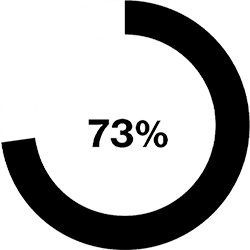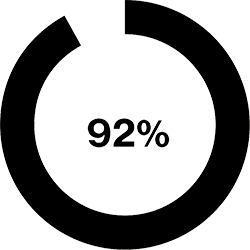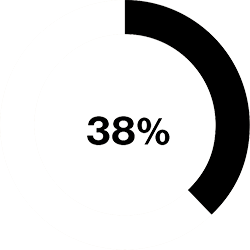How technology is changing the retail experience
Between smartphones, social media, the cloud and the rise of artificial intelligence (AI), the line between the online and physical worlds has changed. Here are six ways brick-and-mortar retailers can leverage small business digital transformation and innovative technologies to thrive.
1. Improve the in-store experience
Integrating your website with your in-store experience can help improve the customer experience and capture more revenue. Use connected small business technology to:
- Allow customers to browse and pay online for in-store pickup
- Sync inventory across stores so customers can find what they need when they need it
- Leverage loyalty programs to build more robust customer profiles using online and in-store transactions

of retail transactions now involve a digital touchpoint.1
2. Curb loss prevention
Don’t let your products or revenue walk out the door. Advanced small business technology can help you stop thieves, reduce fraud and improve the customer experience by allowing you to:
- Track stolen items with RFID tags
- Use data from RFID tags to better secure your most targeted items
- Use AI-powered smart surveillance systems to detect theft in action or notify you when known thieves enter the store

of retail business leaders prioritize loss prevention in their technology investments.2
3. Streamline operations with automation
- Track inventory and reorder stock using internet of things (IoT) sensors and inventory management software
- Schedule employees based on availability and expected foot traffic with an AI-powered workforce management platform
- Adjust pricing based on increased costs via electronic shelf labels

Experts anticipate $430 billion in retailer cost savings with automation by 2026.3
4. Drive revenue with streamlined payments
Customers want to pay with cash, credit cards, gift cards, mobile wallets, QR codes, digital currencies and everything in between. Upgrade your payments systems to:
- Accept digital payment methods like Apple Pay and Google Wallet
- Enable employees to check out customers from anywhere in the store with smartphones and tablets
- Integrate purchase data into your loyalty program to better understand your customers’ needs

Emarketer predicts $1.2 trillion in-store mobile payments by 2028—doubled from $670 billion today.
5. Enhance staff productivity and training
Connected platforms enable staff to work more efficiently while also improving their knowledge and skills. Use small business technology to help employees:
- Communicate with one another in near real time through instant messaging tools—whether they’re in a store location, in the warehouse or at headquarters
- Answer questions about product stock and availability using mobile devices and cloud-based inventory systems
- Onboard faster and develop new skills with on-demand learning management platforms

of retail business leaders prioritize associate productivity in their technology investments.4
6. Deliver an innovative customer experience
Brick-and-mortar stores can use advanced digital point of sale (POS) technologies to make the in-store shopping experience even more immersive:
- Use augmented reality/virtual reality (AR/VR) for virtual in-store product demonstrations
- Display dynamic content like videos or new promotions using digital signage
- Leverage AI-powered chatbots in kiosks to answer questions or suggest products

Only 38% of retail business leaders are satisfied with their in-store digital experience, indicating room for growth.5
Learn more
Learn how to better engage modern customers and drive revenue by transforming your business with digital solutions.